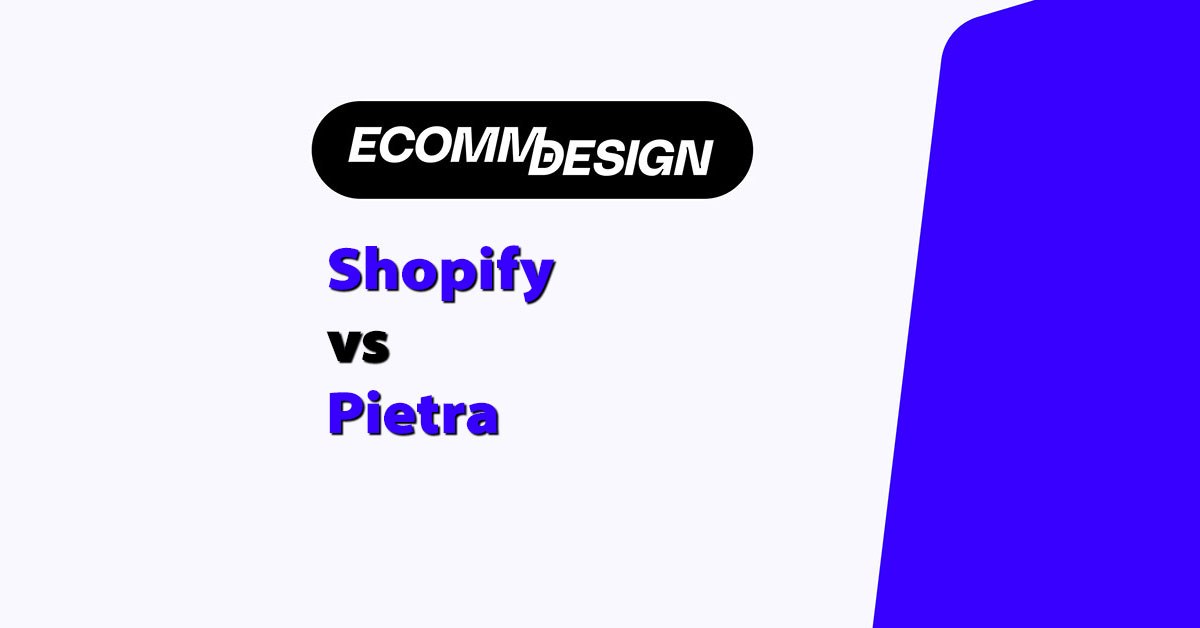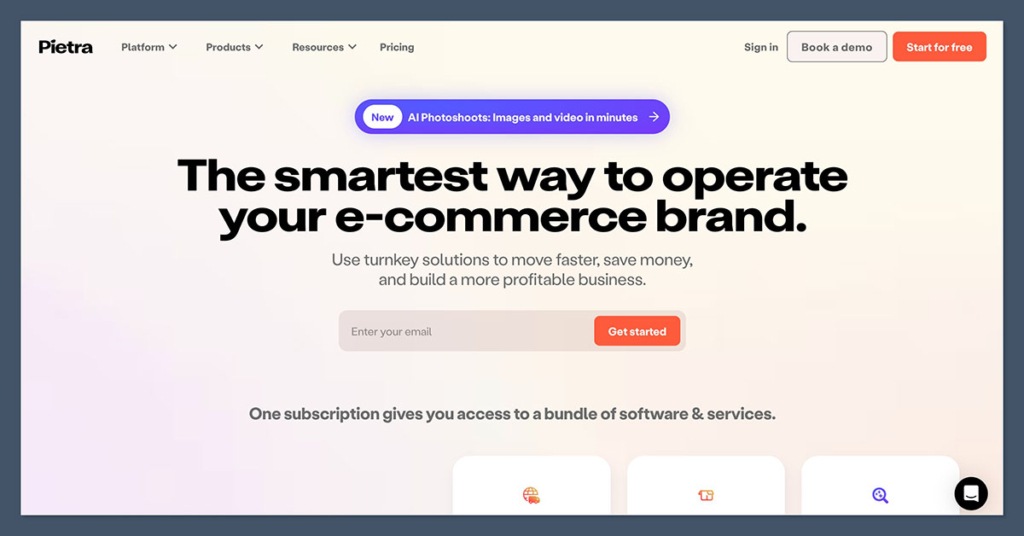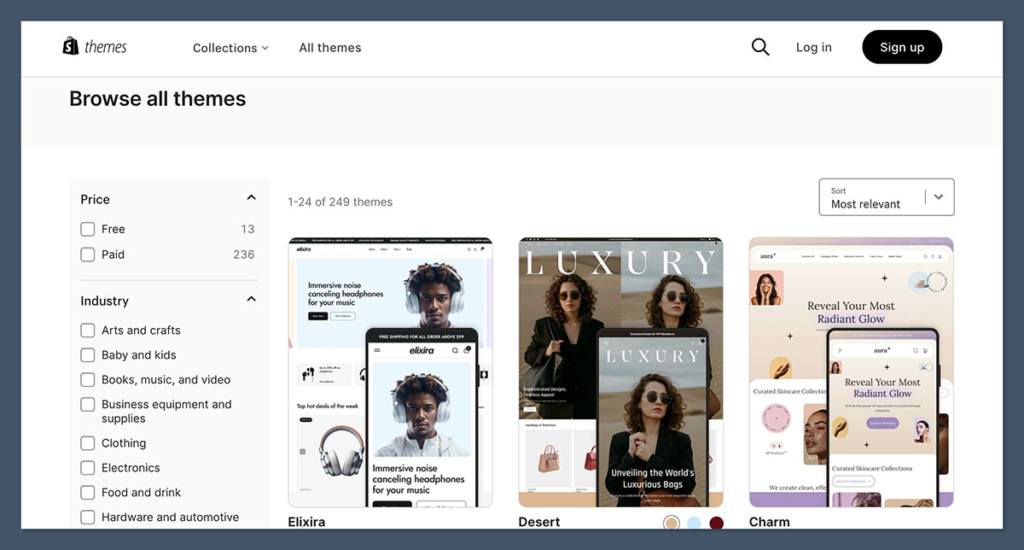
Pietra and Shopify are two ecommerce platforms with very different goals — but which one is the better choice for your online store?
I’ve spent hours testing and comparing both platforms across key areas like pricing, features, templates, scalability, and support to help you make the right decision.
After my deep testing, Shopify is the clear winner if you want to build, grow, and scale a serious online store.
At our ecommerce design gallery, we’ve spent the last 10 years analyzing nearly 20,000 online stores to handpick the best for our collection — now showcasing almost 4,000 top stores and counting.
This has given us a unique view into the real-world platforms that power the most successful, best-designed ecommerce brands.
Through this work, one thing has become clear: Shopify consistently dominates among the leading online stores we feature.
With that in mind, I wanted to take a closer look at how Shopify compares to Pietra — another growing ecommerce platform aimed at creators and emerging brands.
In this review, I’ll break down Pietra vs Shopify across key areas like pricing, features, templates, scalability, and support to help you pick the right platform for your goals.
Pietra vs Shopify: Quick Verdict
Shopify – Best overall for growing and scaling an ecommerce business
Pietra – Best for creators launching branded physical products
In this review, I’ll dig into why Shopify offers the better long-term platform, but Pietra can be a great fit for certain smaller brands.
Pietra is best for:
- Influencers or creators wanting to launch private-label physical products
- Small boutique brands that prioritize simplicity over full customization
Shopify is best for:
- Businesses looking to scale into six or seven figures
- Online stores needing deep customization, apps, and international growth
Quick Comparison: Pietra vs Shopify
Get a quick snapshot of how Pietra and Shopify stack up:
| Feature | Pietra | Shopify |
|---|---|---|
| Overall Rating | 4.0 | 4.8 |
| Starting Price | Free plan, then $39/month Creator Pro | $39/month Basic plan |
| Pros | Product sourcing, warehousing included, fast brand launch | Huge app market, advanced SEO, scalable infrastructure |
| Cons | Limited website design, fewer marketing tools | App costs can stack up, transaction fees unless using Shopify Payments |
| Free Plan/Trial | Free starter access; paid services after | 3-day free trial + 3 months for $1 |
| Best For | Creators and small lifestyle brands | Growing ecommerce stores |
Pietra vs Shopify: Which Platform Wins?
Pietra and Shopify are two ecommerce platforms with very different goals — but which one is the better choice for your online store?
I’ve spent hours testing and comparing both platforms across key areas like pricing, features, templates, scalability, and support to help you make the right decision.
After my deep testing, Shopify is the clear winner if you want to build, grow, and scale a serious online store.
Pietra vs Shopify: Quick Verdict
Shopify – Best overall for growing and scaling an ecommerce business
Pietra – Best for creators launching branded physical products
In this review, I’ll dig into why Shopify offers the better long-term platform, but Pietra can be a great fit for certain smaller brands.
Pietra is best for:
- Influencers or creators wanting to launch private-label physical products
- Small boutique brands that prioritize simplicity over full customization
Shopify is best for:
- Businesses looking to scale into six or seven figures
- Online stores needing deep customization, apps, and international growth
Quick Comparison: Pietra vs Shopify
Get a quick snapshot of how Pietra and Shopify stack up:
| Feature | Pietra | Shopify |
|---|---|---|
| Overall Rating | 4.0 | 4.8 |
| Starting Price | Free plan, then $39/month Creator Pro | $39/month Basic plan |
| Pros | Product sourcing, warehousing included, fast brand launch | Huge app market, advanced SEO, scalable infrastructure |
| Cons | Limited website design, fewer marketing tools | App costs can stack up, transaction fees unless using Shopify Payments |
| Free Plan/Trial | Free starter access; paid services after | 3-day free trial + 3 months for $1 |
| Best For | Creators and small lifestyle brands | Growing ecommerce stores |
Best for Pricing: Shopify
Pietra and Shopify price themselves differently based on what you’re trying to build. At first glance, Pietra might seem like the more affordable option.
You can open an account for free and only pay for services you use. But once you start launching products and handling real sales volume, Shopify quickly proves to offer better overall value.
Pietra’s pricing model works like this:

- Free account access
- Paid services for sourcing, warehousing, and fulfillment
- Creator Pro plan: $39/month for discounted rates and added features
It’s great for creators who are just testing the waters. However, the moment you start ordering samples, manufacturing products, paying for storage, and managing fulfillment fees, costs can snowball quickly.
What looks free at the start can easily cost hundreds or thousands of dollars per month depending on your inventory size and order volume.
Shopify’s pricing is much more straightforward:
- Basic – $39/month
- Grow – $105/month
- Advanced – $399/month
- Plus – Custom pricing for enterprise-level features
Note: Shopify recently updated the names of its plans — the previous “Shopify” plan is now called Grow, and the top-tier Shopify Plus plan remains available for high-volume businesses needing enterprise-grade features.
With Shopify, you’re paying for a complete ecommerce system.
Hosting, storefront, payment processing (via Shopify Payments), checkout optimization, and access to 7,000+ apps are all included.
Even when you add in optional extras like paid themes ($100–$500 one-time) or premium apps, you still get a fully scalable platform without worrying about unpredictable service fees tied to every order or shipment.
While Pietra offers a tempting free entry point, Shopify’s pricing stays stable and predictable as you grow.
You know exactly what you’re paying each month, which makes budgeting and forecasting much easier — especially when you start scaling.
The Winner
Shopify wins for pricing, offering better value across the full store-building journey and saving you from hidden fees as you grow.
Best for Selling Online: Shopify

When it comes to selling online, Shopify is built to scale with you. Pietra covers the basics well, but Shopify’s features go much deeper.
Sales Features
Shopify’s features include:
- Abandoned cart recovery
- Discount codes
- Multichannel selling (Amazon, TikTok, Instagram)
- 7000+ app integrations for upsells, loyalty programs, subscriptions, and more
Pietra’s platform focuses on:
- Easy product creation
- Warehousing and fulfillment integration
- A Creator Marketplace (limited reach compared to Shopify’s sales channels)
Shopify’s ecosystem allows you to connect with massive audiences across every channel imaginable, while Pietra keeps you mainly tied to your own direct sales and a smaller marketplace.
The Winner
Shopify wins easily for sales features.
Its multichannel options and powerful sales apps make it ideal for serious growth.
Payment Options: Shopify
Getting paid easily is a deal-breaker for any ecommerce platform. Shopify offers far more flexibility here.
Shopify’s payment setup:
- 100+ supported payment gateways
- Shopify Payments (lower fees if you use it)
- Apple Pay, Google Pay, PayPal, Amazon Pay
Pietra’s payment setup:
- Stripe-powered checkout
- Credit/debit cards only unless you modify Stripe settings manually
With Shopify, customers can check out using almost any method they prefer, and you can accept payments worldwide with multi-currency support built-in.
Pietra works fine for U.S. payments but feels limited when expanding internationally or offering buy-now-pay-later services like Klarna or Affirm.
The Winner
Shopify offers far more payment flexibility for local and international customers.
Best Features and Tools: Shopify
This category wasn’t even close.
Shopify gives you:
- 7000+ apps
- Full analytics dashboards
- Built-in SEO tools
- Shopify Payments and POS system options
- Advanced shipping rules and automations
Pietra provides:
- Product sourcing tools
- Warehousing/fulfillment setup
- Basic storefront builder
- Limited SEO and marketing features
Pietra’s toolset is great for launching products, but you’ll hit walls fast if you want to run complex marketing, customize customer journeys, or expand your store heavily.
Shopify’s app market, meanwhile, lets you create loyalty programs, automate emails, build subscription boxes, and run SEO campaigns without needing custom coding.
The Winner
Shopify crushes Pietra when it comes to features, flexibility, and advanced tools for ecommerce growth.
Best for Store Templates and Design: Shopify
Your store’s first impression matters.
Whether you’re selling one product or hundreds, the way your website looks will impact customer trust, engagement, and ultimately, conversions.
A sleek, professional design isn’t just about aesthetics — it’s a major part of building a real brand.
When testing both platforms, Shopify’s design system was leagues ahead of Pietra’s basic builder.
Shopify offers:
- Over 190 professional templates
- 13 free themes + premium templates ($100–$500 one-time)
- Full customization with code access if needed
- Mobile-optimized designs

Shopify’s templates cover a huge range of industries, from fashion and beauty to tech and home goods.
The themes aren’t just attractive — they’re built with ecommerce functionality in mind, like optimized product pages, fast loading speeds, and smart navigation layouts.
If you want full control, Shopify also gives access to HTML/CSS editing, so you can customize every part of your store if needed.
Pietra’s storefront builder is much simpler:
- Simple and easy to launch quickly
- Limited design flexibility
- Basic mobile responsiveness
Pietra focuses more on helping creators launch a product line fast rather than giving you deep design control.
It’s fine if you just need a basic shop to start taking orders, but it feels limiting if you’re trying to build a unique brand identity or offer a rich shopping experience.
If you care about making a polished, branded storefront that stands out, Shopify is clearly the better choice.
The ability to tweak, customize, and scale your design over time gives Shopify stores a major advantage — especially as your brand grows and customer expectations get higher.
The Winner
Shopify gives you better design options for branding, user experience, and long-term flexibility.
Scalability: Shopify
Scaling matters if you’re serious about building a 6- or 7-figure brand. Shopify is built to grow with you at every step.
Shopify can handle:
- Thousands of products
- Multi-location inventory
- International storefronts (localized languages + currencies)
- Wholesale pricing models
- Built-in POS system for physical retail
Pietra shines for boutique brands but wasn’t designed for complex scaling needs like multi-warehouse fulfillment or multi-currency storefronts. If you outgrow Pietra’s system, migrating later would be painful and expensive.
The Winner
Shopify wins easily if scaling is even slightly part of your future plan.
Business Support: Shopify
Good support matters — a lot — once real customers and orders are on the line.
Shopify’s support network includes:
- 24/7 live chat
- Phone support (Shopify Plus plans)
- Huge Help Center with tutorials, forums, and videos
- Access to Shopify-certified Experts if you need help
Pietra’s support:
- Email-based (24–48 hour response time)
- Limited live chat based on paid plan
- Small knowledge base
While Pietra’s team is helpful, Shopify’s massive global support operation means you get faster answers when you really need them.
The Winner
Shopify offers much stronger customer support options, giving you peace of mind as you grow.
How We Test Ecommerce Platforms
I thoroughly tested Pietra and Shopify by setting up real stores, connecting payment gateways, creating product listings, and testing checkout flows.
I measured platform performance across these areas:
- Sales features – 40%
- Website features – 15%
- Help and support – 12%
- Design functionality – 10%
- User experience – 10%
- Customer score – 8%
- Value for money – 5%
Testing both platforms first-hand helps give you a clear, unbiased view of their strengths and weaknesses — not just marketing claims.
Pietra vs Shopify: Our Winner
If you’re looking to build a brand, control your store fully, and scale over time, Shopify is the clear winner.
It outperformed Pietra in almost every major category — from sales features to scalability to support.
Pietra, however, is still a smart choice for small creators launching physical products without wanting to deal with sourcing and fulfillment logistics.
If you’re serious about long-term ecommerce success, Shopify is where you should build.






